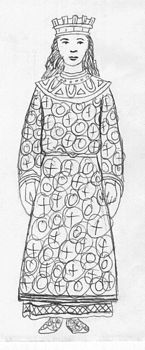
This princess is wearing a wide-sleeved robe (dalmatica).
Robes/Dalmatika
-
Princesses, noblewomen and their entourages preferred long, unbelted (? - many illustrations clearly show belts) robes
topped with an open cloak. These were decorated with edging along the
seams. [Refer also to "Ceremonial Costume" on main page.] (Pushkareva97)
- These robes seem to have been a longer version of the navershnik. I'm also starting to think that these robes were the precursurs of the letnik. It seems the earliet letniki did not have split sleeves, which would make them basically identical to the dalmatika robes. See below.
-
The word "letnik" is likely to be related to the Russian word for summer "leto", but is also similar to root of words such as letet' (to fly) and letchik (pilot), which has appeal because of the wing-like form of the sleeves of the Russian style letnik (unlike the Polish letnik). (Katzner and Dal' dictionaries).
- Letniki were a light women's garment with long and
wide sleeves ("nakapkami") that were left open along the bottom.
They seem to have been worn only later in the
period of Kievan Rus, or more properly appanage Rus under the Mongols,
appearing in the costume of noble city-dwellers in the
14-15th centuries. The will of the Verejski and Beloozero Prince Mikhail
Andreevich referred to his wife's dresses. They included letniki sewn of
striped ob"yar, green and yellow kamki. Sleeves of letnikov were frequently
embroidered "voshvami" - with striped aksamite, of black and crimson.
(Pushkareva89)
- Ob"yar' and kamka were imported silk fabrics. Ob"yar is a silk moire, often with gold or silver, popular in 15th-17th century Rus. Kamka is imported (Chinese) silk with broad/abstract patterns in a single color. (Zhargon)
- "Voshvy" are decorative appliques/borders made of fine fabrics such as aksamite/velvet/taffeta in shapes such as circles or lozenges and richly ornamented with pearls, precious stones, metal plaques, embroidery, etc. (Zhargon)
In the 13-17th cent, probably the most characteristic women's upper garment was the letnik, a loose, not very long (since the foot was visible) gown with wide sleeves (which were called napapkami) and decorated with special sewn-on strips, voshvy, of other materials. "Letnik of crimson damask with golden green brocade voshvy". Voshvy were evidently kept separate and sewn on different letniki. The 1503 will of Volotskoj princess, Yuliana, names 12 voshvy and 4 letniki without voshvy. In the opinion of I.E. Zabelin, the letnik was generally put on over the head, but there were also open-front letniki, called opashnitsa. In the description of letniki almost never are recorded buttons. The letnik was worn over the sorochka and sarafan. It was a specifically women's garment. (Rabinovich, 13-17th c.)
The most typical female outer clothing of the 15th century was the letnik – free [loose], not too long (so that the feet are still visible), with wide sleeves. The letnik is decorated with additional special stripes - voshvy made of another material. Voshvy, apparently, were stored separately and could be sewed onto different letniki. So, in the will of Volockoj princess Julianii (1503) are named 4 letnik without voshv and, separately, 12 voshv. "Voshva on one were gathered, sewn with gold and set with pearls, and the pearls from it were cut off, and have remained few" (DDG, 87, with. 349 350). (Bykov/Kuzmin)
Letnik is a specifically female outer garment which was never worn by men. (Bykov/Kuzmin)
The letnik reconstructed on the Partizan webpage is sewn from heavy red linen (or wool). The round ozherlya-oplech'e [“o” means around, “plech” means shoulder] is clasped in back with three hidden buttons. The voshvy and a collar were made from black velvet [barkhata], embroidered with river pearls, mother-of-pearl and gilt beads [biser], and also small semi-precious stones. Sleeves are edged with valuable fur. (Bykov/Kuzmin)
- Ob"yar' and kamka were imported silk fabrics. Ob"yar is a silk moire, often with gold or silver, popular in 15th-17th century Rus. Kamka is imported (Chinese) silk with broad/abstract patterns in a single color. (Zhargon)
-
Women's winter "korteli" were garments, analogus to letnik, but lined with
fur - marten, squirrel, sable, ermine and decorated with various-colored
"voshvy" - green, blue, black, "chervchatye" (raspberry/crimson).
(Source? - Kolchin?)
A warm letnik with the same sleeves and voshvy, but lined with fur was called kortel', kortli, or torlop. (Rabinovich, 13-17th c.)
Comments and suggestions to lkies@jumpgate.net.
Back to Women's Clothing or Early Rus Clothing.
Back to Russian Material
